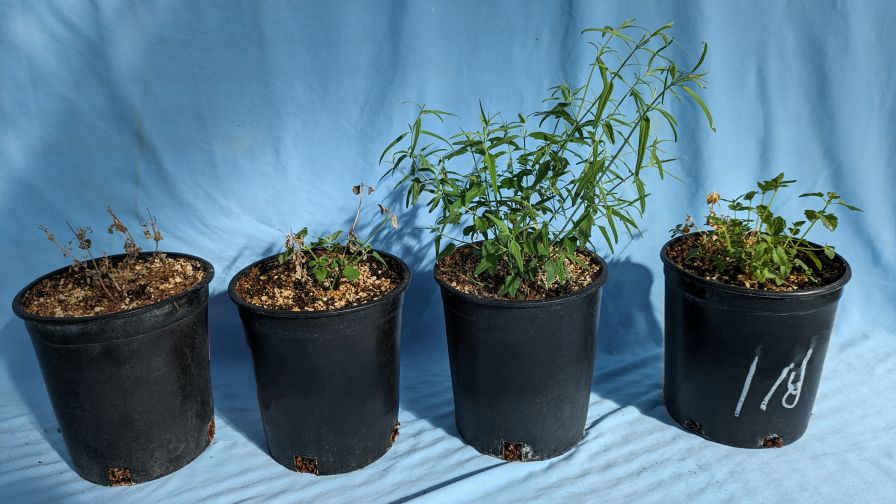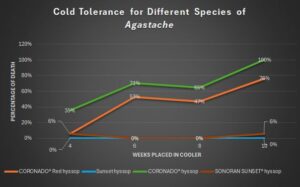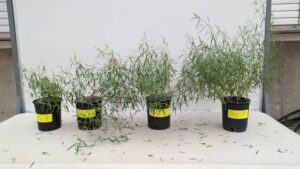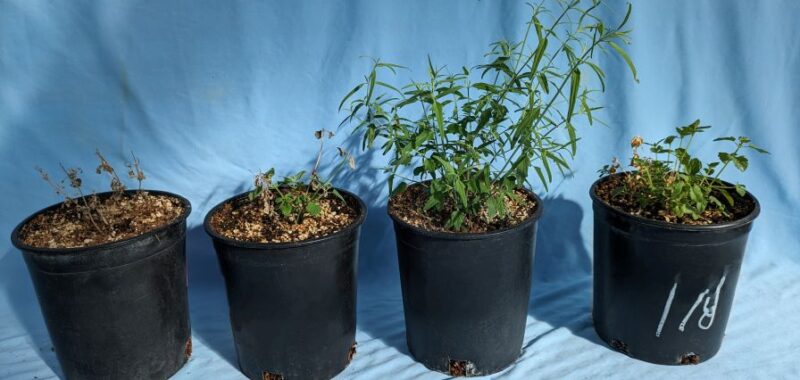
10-week chilling treatment | James Klett
Editor’s note: This is the first installment of a two-part series on Agastache chilling experiments from Colton Davis, Jim Klett, and Ronda Koski of Colorado State University. The second installment will be posted on Thursday, July 11, 2024.
Agastache is a genus in the Lamiaceae (mint) family. Known as giant hyssops, these perennials have beautiful foliage that produces a strong and sweet fragrance when brushed against. There are about 22 different species of Agastache, and they are native to the Russian Far East, China, Eastern Asia, Subarctic America, Western and Eastern Canada, the U.S., and Mexico. Agastache normally grows in mountains or deserts, is edible, and can be used as an herb, in tea, or for medicinal purposes.
This study focused on four different taxa of Agastache: A. rupestris (Sunset hyssop), A. cana ‘Sinning’ (Sonoran Sunset hyssop), A. aurantiaca ‘P012S’ (Coronado hyssop), and A. aurantiaca ‘Pstessene’ (Coronado Red hyssop). These Agastache are native to Arizona, New Mexico, and Mexico, and the flower colors range from sunset-orange and mauve to lavender-rose; yellow and orange to reddish-orange.
These Agastache are in the Plant Select program and are promoted for xeriscape landscaping. However, plant availability can be limited due to propagation problems related to early flowering. To improve the availability of vegetative cuttings, we researched growing Agastache stock plants under differing periods of chilling. During the experiments it was found that different species of Agastache have distinct differences in cold tolerance; two species were found to be less cold tolerant than the others. Two experiments were conducted over several months, and similar results were observed.
Two experiments were conducted between September 2023 and April 2024. Replicates of each species of Agastache were placed in a cooler between 35°F and 40°F without light and monitored for a certain number of weeks. A control set of replicates was kept in the greenhouse and the other sets were placed in the cooler for four, six, eight, or 10 weeks. Experiment 1 had 10 replicates per set while Experiment 2 had seven replicates per set. The plugs used in the study were purchased from Gulley Greenhouse and Garden Center and were transplanted into 1-gallon containers. The plugs for both experiments were acquired at the same time from the same seed source.

Cold tolerance for different species of agastache | James Klett
After transplanting, Experiment 1 was placed on the greenhouse bench for six weeks and Experiment 2 was placed for four weeks before being moved into the cooler. All plants were cut back to a uniform height a week prior to being placed into the cooler and a Palladium fungicide drench was placed on all plants to help prevent root rot. After the plants had been in the cooler for their respective treatment time they were taken out and placed on the greenhouse bench.
Initially, all Agastache were fertilized with a 100ppm N (20N-10P2O5-20K2O) fertilizer solution once a week, and as the plants grew, they began to be fertilized with each watering. The replicates were monitored for reproductive growth weekly and flowering data was recorded at that time. Once all the Agastache in a treatment were showing signs of flowering, photos were taken, the date was recorded, and the plants were harvested. Any Agastache that died during the experiment was recorded with dates as well.
When evaluating both experiments, it was found that two species of Agastache were more cold-tolerant than the others. Sunset hyssop resulted in no death occurring during any treatments throughout the study, and Sonoran Sunset hyssop had little death across all the chilling treatments. Sonoran Sunset hyssop had 6% death for the four-week and 10-week chilling treatments but no deaths occurred in six or eight weeks of chilling. This study illustrates that these two species of Agastache are tolerant to chilling for up to 10 weeks at around 35-40°F. Additionally, these cultivars may be more tolerant to colder temperatures since there was limited death at this temperature range.
Coronado hyssop and Coronado Red hyssop showed different responses to chilling than Sunset hyssop and Sonoran Sunset hyssop. Coronado hyssop was the least tolerant to the cold when looking at both experiments with 35% death after four weeks of chilling and 100% death in the 10-week chilling treatment. Coronado Red hyssop was able to tolerate four weeks of chilling with a 6% death rate, but by six weeks of chilling the death rate increased to 53%. With such a death rate occurring at temperatures of 35-40°F, these two taxa should not be planted in zones prone to temperatures below freezing unless they are being planted as an annual.

Sunset hyssop for agastache chilling treatment | James Klett
Coronado hyssop and Coronado Red hyssop originate from Mexico, whereas the Sonoran Sunset hyssop and Sunset hyssop originate from New Mexico, Arizona, and western Texas. The Coronado hyssops originate in a region that is more southern than the others, potentially giving it different genetics related to cold tolerance. This would explain why it wasn’t as cold tolerant as the Sonoran Sunset hyssop and Sunset hyssop. The cooler being used for this study was not set to freezing temperatures and there was still significant loss in the two Coronado hyssop taxa. Due to this, the recommended hardiness zones to grow these taxa as a perennial is hardiness Zone 7 or higher. Sunset hyssop was shown to have the strongest tolerance to cooling events which indicates why this taxon is being grown successfully in hardiness Zone 5 or higher.
This information can be utilized by growers and landscapers alike. It would be beneficial to plant the Coronado hyssop and Coronado Red hyssop in hardiness Zones 7 or higher as a perennial and plant them as an annual below this zone. Sunset hyssop and Sonoran Sunset hyssop are more reliably cold tolerant and can be planted in colder climates as a perennial. Plant hardiness Zone 5 or higher is recommended for these two Agastache.

